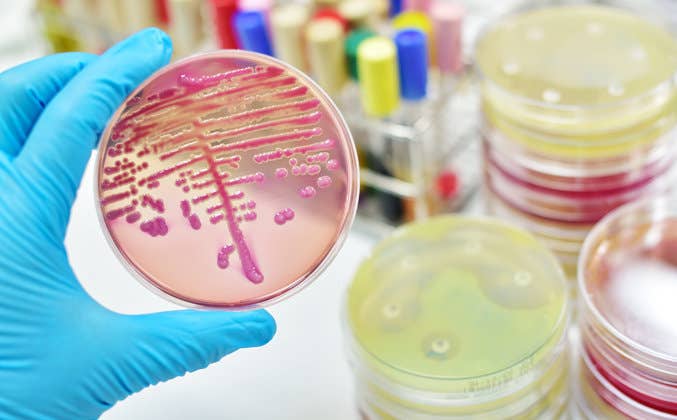New antibiotic fights drug-resistant bacteria to stop deadly infections
Lariocidin, a new lasso peptide antibiotic, attacks bacteria in a fresh way, bypassing resistance and showing strong results in animal tests.

Lariocidin, a new antibiotic, blocks bacterial protein production and defeats resistance without harming human cells. (CREDIT: Shutterstock)
A groundbreaking antibiotic discovery might finally tip the balance in the global fight against drug-resistant bacteria. Scientists have unveiled a rare molecule with a fresh way to stop dangerous infections—offering new hope after nearly 30 years without a new class of antibiotics.
A Soil Discovery Sparks New Hope
Deep within a simple backyard soil sample, researchers uncovered a rare bacterium that makes a powerful new compound. This compound, called lariocidin, is part of a group of unusual molecules known as lasso peptides. These molecules form a tiny knot-like shape that locks them into a rigid structure. This unique shape makes them more stable and more likely to survive long enough to fight harmful bacteria.
The research team at McMaster University, led by biochemistry professor Gerry Wright, discovered lariocidin from bacteria that had quietly grown in a lab for a year. “Bacteria aren’t interested in making new drugs for us,” Wright explained. “We let them grow slowly so even the shy ones had a chance to be seen.” One species—Paenibacillus—produced something remarkable. It wasn’t just killing other bacteria, it was doing so in a completely new way.
This is a major achievement. Scientists haven’t introduced a new antibiotic class into the market in decades. Now, with lariocidin, they have a chance to reshape the way medicine treats infections.
Lariocidin’s Unique Battle Plan
Lariocidin works differently than most antibiotics. It doesn’t simply damage a cell wall or block an enzyme. Instead, it targets the ribosome—the part of a bacterial cell that makes proteins. Proteins help bacteria grow, repair damage, and stay alive. When the ribosome breaks, bacteria can’t make proteins and eventually die.
Lariocidin slips into a spot on the ribosome that no other drug has targeted. It binds to the small subunit of the ribosome and locks onto a stretch of genetic material called 16S rRNA, along with the aminoacyl-tRNA, which helps build proteins.
Related Stories
This tight grip blocks the process of “translocation,” where ribosomes move along the genetic code to build proteins. It also scrambles the genetic message, causing the bacteria to build the wrong proteins. This double hit—blocking movement and messing up the message—kills the cell.
“This is a new molecule with a new mode of action,” said Wright. “It’s a big leap forward for us.”
Defeating Resistance with Smart Science
The biggest advantage of lariocidin is that bacteria haven’t seen it before. That means they haven’t developed defenses against it. Most antibiotics become less effective over time because bacteria find ways to fight back—a problem known as antimicrobial resistance, or AMR.
AMR is a growing crisis. According to the World Health Organization, antibiotic resistance now causes about 4.5 million deaths each year. Old drugs fail more often, and fewer new ones are being developed to replace them. That’s why this new antibiotic is getting so much attention.
Lariocidin avoids the traps that cause most drugs to fail. It resists common resistance mechanisms, doesn’t trigger spontaneous resistance, and shows no signs of harming human cells. This means it could be safer and more effective than many antibiotics used today.
Manoj Jangra, a postdoctoral fellow on the team, said the moment they understood how lariocidin worked was unforgettable. “When we figured out how this new molecule kills other bacteria, it was a breakthrough moment.”
The team also tested lariocidin’s power in living organisms. In a mouse model infected with the highly resistant Acinetobacter baumannii—a bacteria often found in hospitals—lariocidin performed well, clearing the infection without causing harm to the animals. This result raised even more excitement about its potential use in people.
The Road Ahead: From Molecule to Medicine
Despite the excitement, bringing lariocidin to hospitals won’t be fast or easy. Although nature made this molecule, scientists now have to figure out how to mass-produce it. “The initial discovery—the big a-ha! moment—was astounding for us,” Wright said. “But now the real hard work begins.”
Making enough lariocidin for use in people will take years of testing and careful design. Researchers plan to tweak its structure to improve its strength, stability, and production. “We’re now working on ripping this molecule apart and putting it back together again to make it a better drug candidate,” said Wright.
Even small changes in the molecule can make a big difference in how well it works. The researchers want to keep the parts that kill bacteria but modify others to make the drug easier to produce and safer for human use.
A Big Leap in the Antibiotic Fight
Lariocidin might become a key weapon in the war against resistant infections. Its discovery marks a rare moment in science where everything clicks—an unexplored soil bacterium, a molecule with a clever shape, and a completely new way to attack the ribosome. Its success in lab tests and animals shows that nature still holds answers to one of medicine’s most urgent problems. By studying how bacteria fight each other in the wild, scientists might finally stay one step ahead of superbugs.
As the team at McMaster continues refining this promising compound, one thing is clear: new hope is growing, not in high-tech labs, but in soil, patience, and smart science.
Research findings are available online in the journal Nature.
Note: The article above provided above by The Brighter Side of News.
Like these kind of feel good stories? Get The Brighter Side of News' newsletter.



